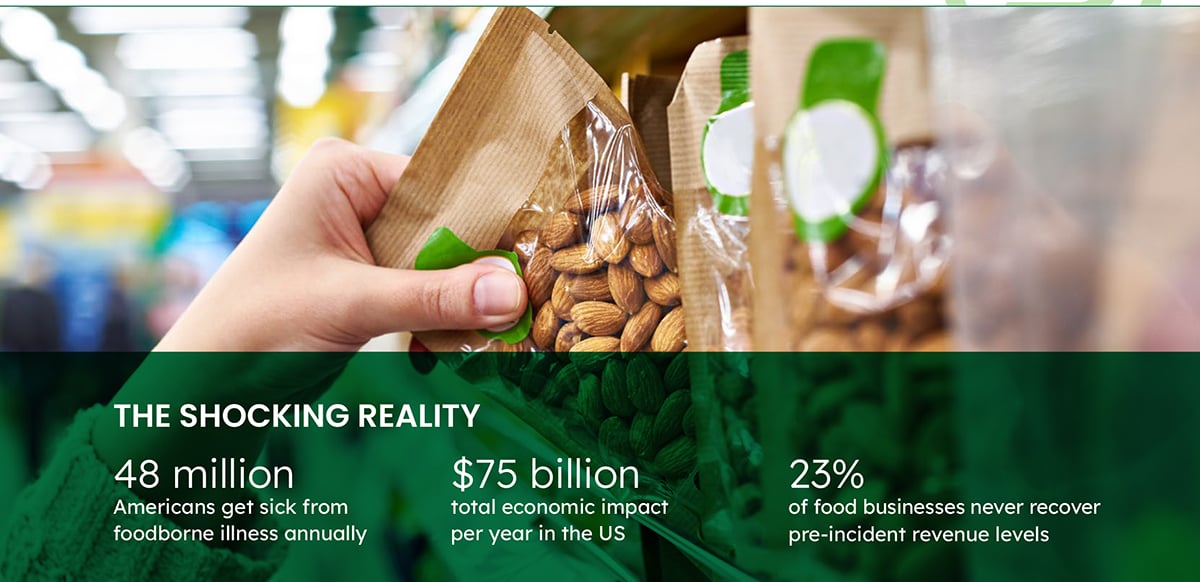Why Food Safety Failures Cost More Than You Think
Why investing in food safety prevention is crucial! Learn about the hidden costs of food safety failures and how to protect your business from financial disaster.
The Staggering Numbers Behind Food Safety Failures

Every year, approximately 48 million Americans get sick from foodborne illnesses. While that statistic is sobering enough, the economic impact tells an even more compelling story. The CDC estimates that foodborne diseases cost the US economy $75 billion annually in medical treatments, lost productivity, and other related expenses.
But these macro numbers only tell part of the story. For individual businesses, the costs can be absolutely devastating.
The Real Cost Breakdown: Beyond the Headlines
Here's what most businesses discover too late:
Per incident, depending on severity and scope
Average cost of a Class I recall
Sales decline in the first year post-incident
Time to rebuild consumer trust
The Domino Effect Timeline
How Costs Escalate: A Typical 90-Day Journey
Case Study: When Small Problems Become Big Disasters

The $20 Million Salad
A mid-sized produce company with $50M in annual revenue experienced a listeria contamination in their bagged salad products.
The initial problem?
A single piece of equipment wasn't being cleaned properly – a $500 fix was overlooked during a busy production period.
After 18 months:
- $12M in recall costs and legal settlements
- $8M in lost revenue during facility shutdown
- $3M in brand rehabilitation efforts
- $2M in additional insurance premiums
- Total: $25M+ impact from a $500 oversight
The Hidden Costs

Legal costs and lost revenue account for 60% of the total damage.
Industry-Specific Vulnerabilities
Restaurants and Food Service: Face immediate reputation damage and can lose 80% of customers within weeks. Recovery typically takes 12-18 months and costs 3-5x the initial incident response.
Food Manufacturers: Deal with supply chain disruptions and retailer relationship damage. A single recall can result in losing shelf space that takes years to regain.
Produce and Fresh Foods: Face seasonal pressures and perishability issues that compound costs. A contamination during peak season can devastate an entire year's profits.
Prevention vs. Recovery Cost
Here's the math that should motivate every food business owner: Comprehensive food safety programs typically cost 0.5-2% of annual revenue. In contrast, a major food safety failure can cost 50-200% of annual revenue.
Investment Comparison:
Annual food safety program for $10M company: $50K-$200K
Major food safety incident cost: $5M-$20M
ROI of prevention: 25:1 to 100:1
The companies that thrive long-term are those that view food safety not as a cost center, but as insurance against catastrophic financial loss. They invest in robust HACCP systems, regular third-party audits, employee training programs, and cutting-edge monitoring technology.
Cost-effective strategies
Based on Amerisan's experience helping companies navigate both prevention and recovery, here are the most cost effective strategies :
Invest in Technology: Food safety monitoring systems and 5S methodology pay for themselves by preventing a single incident: temperature monitoring, pathogen testing, traceability systems, and standardization are necessities.
Employee Training: 80% of food safety failures trace back to human error. Comprehensive, ongoing training programs cost a fraction of a single incident response.
Third-Party Audits/Assessments Save Money: Regular audits by professionals identify problems before they become crises. The assessment fees are minimal compared to the potential costs they help avoid. Amerisan works with clients as a second set of eyes to identify areas for improvement and reduce risk.
Supply Chain Vigilance: Many incidents originate with suppliers. Robust supplier verification programs protect your brand from others' mistakes.
The Bottom Line
With proper planning and investment, food safety failure costs are preventable.
Leadership needs to recognize that every dollar spent on food safety prevention can save $25-$100 in potential failure costs. In an industry where margins are often tight, this might be the best ROI you'll ever see.
The food industry will always carry inherent risks, but the financial catastrophe of food safety failures is completely within your control. It's important to invest in prevention now, or pay exponentially more later. Prevention is not just the smarter choice – it's the only sustainable choice for long-term brand success.